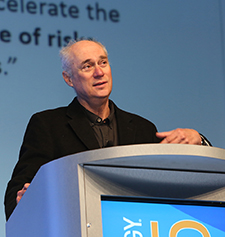
Kirk Hogan, M.D., J.D.: ‘At present, we do not ask patients how they are doing cognitively after surgery, and we don’t tell them that there may be declines after surgery.’
Three months after surgery with general anesthesia, between 10 and 15 percent of patients may have cognitive deficits. The first paper linking anesthesia and cognitive disorders was published in 1887, but physician anesthesiologists and surgeons rarely ask about postoperative cognitive dysfunction (POCD), and patients seldom mention it. A new patient safety initiative focusing on reducing delirium and cognitive disorders following anesthesia addresses 170 years of what is now recognized as POCD.
“At present, we do not ask patients how they are doing cognitively after surgery, and we don’t tell them that there may be declines after surgery,” said Kirk Hogan, M.D., J.D., Professor in the Department of Anesthesiology at the University of Wisconsin. “In the future, we will ask and we will tell. The goal of the initiative is to accelerate the adoption of best practices and ensure patients are aware of the risks when making decisions regarding surgical interventions.”
Dr. Hogan explored the history of POCD Sunday during the Lewis H. Wright Memorial Lecture, “Cognitive Changes After Surgery: Don’t Ask, Don’t Tell.” Caregivers haven’t always heeded case reports and increasingly rigorous research into the cognitive effects of anesthesia.
One objection was the perceived need for pain as a component of healing. There were religious objections. Early accounts of cognitive changes associated with anesthesia did not distinguish between “insanity” and less severe cognitive dysfunction.
While papers in the 1940s and 1950s called for more research into links between neurocognitive declines and anesthesia, researchers in the 1960s tended to focus on other concerns. POCD was not considered a safety concern until the development of cardiac bypass surgery.
“Surgeons and families started reporting cognitive declines following bypass surgery,” Dr. Hogan said. “Research found that up to 30 percent of patients had cognitive declines after cardiac surgery.”
It wasn’t until the late 1990s that researchers began to investigate neurocognitive changes in non-cardiac surgery patients. About 10 percent of patients had demonstrable POCD three months after surgery. Increasing age was the only identified risk factor, which helped inspire studies on associations between anesthetics and changes similar to Alzheimer’s disease in biophysics, cell culture and rodent models.
Inhaled anesthetics increase amyloid oligomerization, activate caspase, promote amyloid beta aggregations, prevent amyloid beta clearance, and cause cytotoxicity and neuronal apoptosis, Dr. Hogan said. There was loss of learning and increased mortality that was worse in older rodents, and worse with specific combinations of anesthetics. Anesthetics also were associated with aseptic inflammatory response and necroptosis, upregulation of a variety of inflammatory cytokines and increased activation of macrophages and CNS microglia.
Dr. Hogan said that half of non-cardiac surgery patients will show signs of POCD at two to seven days after surgery. POCD persists in 12-30 percent of patients at three months and 3-10 percent have persistent POCD at one year.
According to Dr. Hogan, the cause of POCD is debatable and further research into this important safety concern is necessary. “We will be sorting out the effects of anesthesia and surgical trauma for decades to come,” he said.
